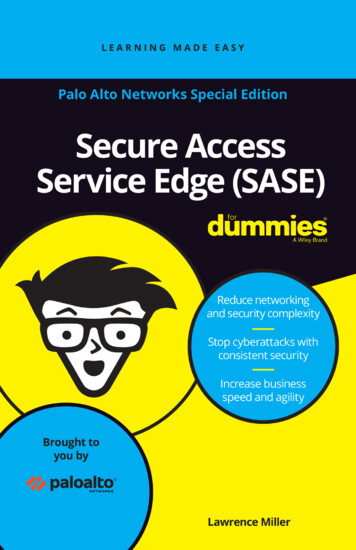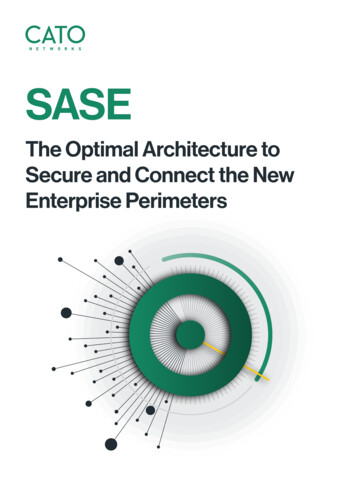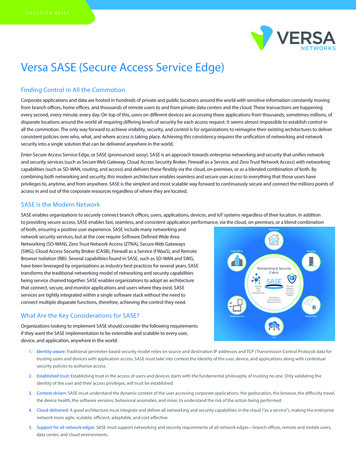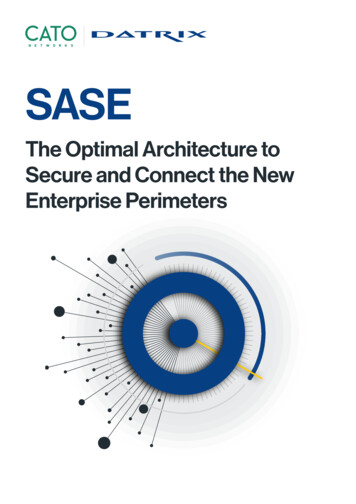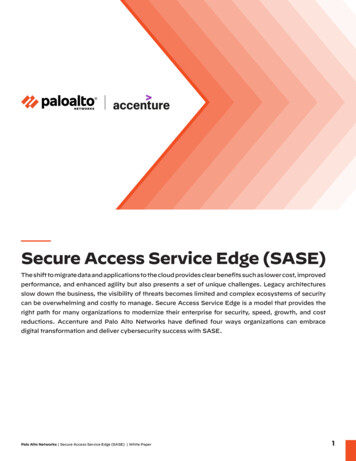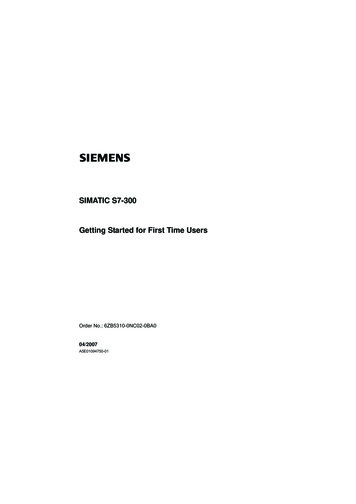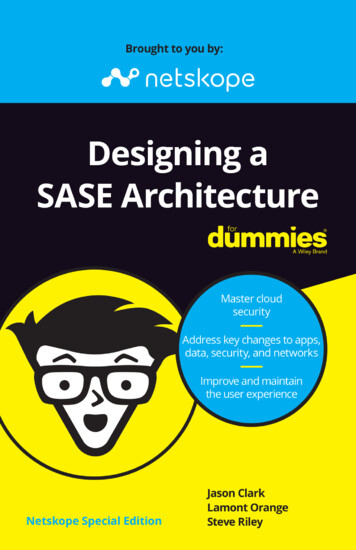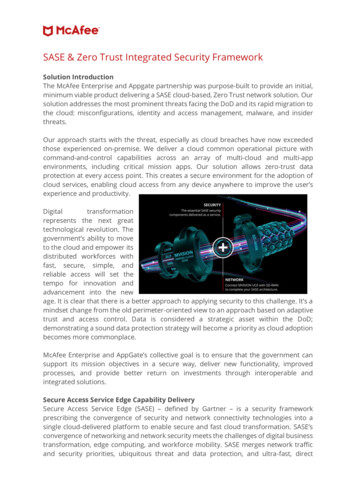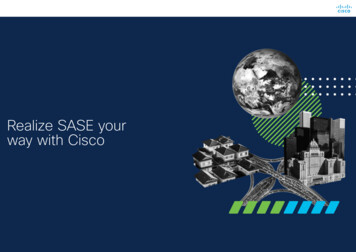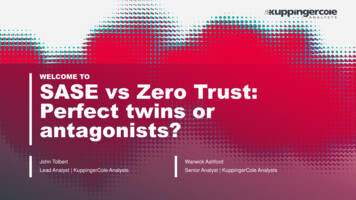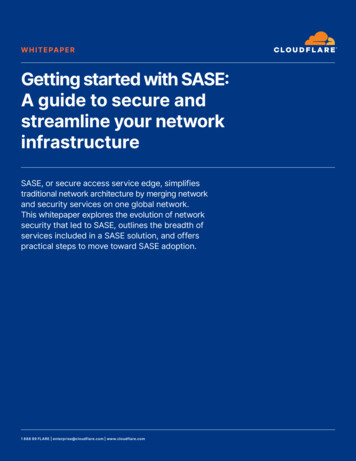
Transcription
W H I T E PA P E RGetting started with SASE:A guide to secure andstreamline your networkinfrastructureSASE, or secure access service edge, simplifiestraditional network architecture by merging networkand security services on one global network.This whitepaper explores the evolution of networksecurity that led to SASE, outlines the breadth ofservices included in a SASE solution, and offerspractical steps to move toward SASE adoption.1 888 99 FLARE enterprise@cloudflare.com www.cloudflare.com
I NTRODUCTIONCoined by Gartner in 2019, secure access service edge, or ‘SASE,’ was initially positioned as a pivotaladvancement in the digital transformation process: highly customizable network and securityservices seamlessly stitched into the fabric of a global cloud platform. With a 20% adoptionrate expected by 2023, Gartner claimed that the demand for SASE capabilities would “redefineenterprise network and network security architecture and reshape the competitive landscape.” 1Since then, the term has spread like wildfire through the IT and enterprise security space. As networksecurity providers and SD-WAN vendors scramble to position themselves as SASE leaders, enterprisesare left with a hastily-assembled jumble of network and security services that approaches, butoften doesn’t fully encompass, a SASE framework.True SASE adoption requires more than bundling existing single-point solutions — it demands acomplete reconsideration of enterprise network infrastructure. Maintaining a rigid on-premisenetwork perimeter is no longer sufficient to protect a distributed, mobile workforce, while jugglingmultiple security services to protect a hybrid infrastructure can be costly, create headaches for ITteams to deploy and manage, and leave massive security gaps.SASE addresses these challenges by shifting the network perimeter from centralized data centersto the user. By consolidating networking and network security services and delivering them froma single, cloud-based platform, SASE eliminates security gaps between services, gives IT teamsgreater visibility into network activity, and simplifies the cloud migration process.1 888 99 FLARE enterprise@cloudflare.com www.cloudflare.com2
1. T H E O R I G I N S O F S A S ETo understand the pivotal shift that SASE represents, it’s important to examine the gradual evolutionof network infrastructure and security.Before the widespread adoption of cloud computing, corporate resources, data, and applicationslived within on-premise facilities that were safeguarded by hardware firewalls and DDoS appliances.Employees in a corporate office accessed internal resources through private connections filteredby network firewalls. Users connecting from remote locations usually did so through a VPN, whichwas prone to latency and overcrowding.Underpinning this setup was a fear of the open Internet — a tool that was first and foremost builtfor resiliency, with little consideration for enterprise performance and security needs. Because theInternet had proven inherently vulnerable to attacks, organizations elected to establish their ownprivate networks that secured (often ineffectively) data, applications, and corporate resources withphysical firewall boxes and DDoS appliances, and tromboned all incoming traffic through centralizeddata centers for inspection and SRegionalData CenterMPLSMPLSRegionalData CenterMPLSMPLSVPNMPLSBranch OfficesOfficesRemote UserThis model of network security was expensive and complex, and still left organizations vulnerableto data breaches and internal threats. Once an attacker breached the network perimeter, they couldwreak significant damage within an organization by spreading malware, taking control of user accounts2,and stealing valuable customer data.3With the advent of cloud and SaaS services, organizations have more freedom and flexibility to reimaginetheir network infrastructure, as applications, data, and employees no longer need to reside exclusivelywithin on-premise facilities.1 888 99 FLARE enterprise@cloudflare.com www.cloudflare.com3
1. T H E O R I G I N S O F S A S EHowever, with that freedom comes new security challenges. IT teams are tasked with protectinga mixture of on-premise and cloud-based services, as well as securing an increasingly mobileand remote workforce.4 Doing so successfully often requires maintaining expensive hardware andlayering single-point security services from multiple vendors, which can be time-consuming toimplement and difficult to manage.The next evolution of network security likely will not resemble the hardware that protected traditional‘hub-and-spoke’ infrastructure or the complex workarounds required by a hybrid cloud architecture.Instead, it will look like a SASE framework, one that consolidates network and security servicesand delivers them as an integrated l Anycast NetworkBranch OfficesData CentersRemote UserContractorsRather than depending on ineffective hardware appliances or patching together siloed security services,SASE offers a streamlined approach to network security. It replaces complicated backhaulingwith the Internet edge, allowing enterprises to route, inspect, and secure traffic in a single pass.Coupled with zero trust access policies and network-level threat protection, SASE eliminates theneed for legacy VPNs, hardware firewalls, and DDoS protection appliances, giving organizationsmore visibility into and control over their network security configurations.1 888 99 FLARE enterprise@cloudflare.com www.cloudflare.com4
2. DEFI N I NG SASE’S SCOPESASE is a cloud-based security model that combines software-defined wide area networking withcore network security services and delivers them on the cloud edge. Most SASE offerings arecharacterized by five primary capabilities:Building and managing networksConnecting users to applicationsA software-defined wide area network (SD-WAN)enables organizations to establish privatecorporate networks without the assistance ofhardware routers or multiprotocol label switching(MPLS) circuits. This virtual, software-basedarchitecture gives enterprises greater flexibilitywhen creating and maintaining their networkinfrastructure, though it also comes withsome built-in security vulnerabilities.Zero trust network access (ZTNA) requiresreal-time verification of every user to everyprotected application in order to protectinternal resources and defend againstpotential data breaches. With a “zero trust”approach, no entity is automatically trusteduntil their identity is authenticated — evenif they are already inside the perimeter ofa private network.Filtering trafficProtecting applications and infrastructureA secure web gateway (SWG) prevents cyberthreats and data breaches by filtering unwantedcontent from web traffic, blocking unauthorizeduser behavior, and enforcing company securitypolicies. It typically includes URL filtering,anti-malware detection and blocking, andapplication control, among other capabilities.Cloud-based firewalls (FWaaS) protect cloudinfrastructure and applications from cyberattacks through a set of security features thatincludes URL filtering, intrusion prevention, anduniform policy management.Securing dataA cloud access security broker, or CASB, performsseveral security functions for cloud-hostedservices (e.g. SaaS, IaaS, and PaaS applications).Standard CASBs secure confidential data throughaccess control and data loss prevention, revealshadow IT, and ensure compliance with dataprivacy regulations.1 888 99 FLARE enterprise@cloudflare.com www.cloudflare.com5
2. DEFI N I NG SASE’S SCOPEAlthough a conventional SASE solution includes the five services outlined above, the list is moreof a starting point than a strict set of requirements. SASE, at its core, converges two fundamentaland separate capabilities — software-based network architecture and cloud-based securityservices — beyond that, vendors may add or subtract additional services as needed.Internet AppsSelf-Hosted AppsSaaS AppsSASEBranch OfficesData Centers1 888 99 FLARE enterprise@cloudflare.com www.cloudflare.comRemote Users6
3 . B E N E F I T S O F A S A S E A P P R OAC HAs it continues to evolve, SASE implementation may vary considerably from vendor to vendor andorganization to organization. Most SASE solutions, however, share several key advantages overon-premise and hybrid network security configurations:Streamlined implementationReduced latencyBy consolidating networking and securityservices, SASE eliminates the need to onboardcloud-based services, set up on-premiseappliances, and invest time, money, andinternal resources to keep both updatedagainst the latest threats.SASE reduces latency and improves performanceby routing network traffic across an expansiveedge network in which traffic is processed asclose to the user as possible. Routing optimizationscan help determine the fastest network pathbased on network congestion and other factors.Simplified policy managementGlobal networkSASE allows organizations to set, monitor,adjust, and enforce access policies acrossall locations, users, devices, and applications.Attacks and incoming threats can be identifiedand mitigated from a single portal, ratherthan individually monitored and managedwith multiple single-purpose security tools.A SASE framework is constructed on top of asingle global network, enabling organizationsto expand their network perimeter to anyremote user, branch office, device, or applicationand gain more visibility and control acrosstheir entire network infrastructure.Identity-based network accessSASE leans heavily on a zero trust securitymodel, in which user identity and access isgranted based on a combination of factors:user location, time of day, enterprise securitystandards, compliance policies, and anongoing evaluation of risk/trust. This levelof security — a significant step up from theoverly permissive and inherently vulnerableVPN — protects against both external andinternal data breaches and other attacks.1 888 99 FLARE enterprise@cloudflare.com www.cloudflare.com7
4 . G E T T I N G S TA R T E D W I T H S A S EFor enterprises that have invested serious time, resources, and money in elaborate on-premisesetups, manage complex webs of cloud-based security services, or are still adjusting to the futureof remote work, SASE adoption can feel daunting — but it doesn’t have to be.Here are five practical steps you can take to get started with SASE:1. Secure your remote workforce.Implement a ZTNA solution that will allow you to reduce reliance on or even replace your VPN, shieldcorporate data and resources from internal and external threats, and improve user experience.By bringing your secure web gateway, firewall, and devices’ browsers to the edge, you can filter,isolate, and inspect traffic without backhauling it through a central data center.2. Place branch offices behind a cloud perimeter.Apply a zero trust architecture to branch offices that will remove the need for on-prem securityappliances (unified threat management, etc.), which can be expensive to maintain and ineffectiveagainst a quickly-evolving threat landscape.3. Move DDoS protection to the edge.Get rid of DDoS appliances and defend corporate networks from attacks with cloud-native,network-layer DDoS protection that can detect and mitigate threats in real time.4. Migrate applications to the cloud.As your organization scales, move self-hosted applications from your data centers to the cloudand make sure to apply consistent network security policies across all traffic.5. Replace on-premise security appliances with unified, cloud-native policy enforcement.Reduce the cost and complexity of maintaining network hardware appliances by shifting policyenforcement to the edge, where you can monitor in a single pass and manage in a single pane alltraffic, attack patterns, and security policies.1 888 99 FLARE enterprise@cloudflare.com www.cloudflare.com8
5. H OW C LO U D F L A R E D E L I V E R S S A S EWhether you call it SASE or simply the new reality, enterprises need flexibility at every layer ofthe network and application stack. Users need secure, authenticated access wherever they are:at the office, on a mobile device, or working from home.Cloudflare One is a comprehensive network-as-a-service (NaaS) solution that simplifies andsecures corporate networking for teams of all sizes.With Cloudflare One, you can: Embrace zero trust access. Replace broad security perimeters with one-to-one verificationof every request to every resource. Enforce zero trust rules on every connection to yourcorporate applications, no matter where or who users are. Secure Internet traffic. When threats on the Internet move fast, the defenses you use to stopthem need to be more proactive. Cloudflare One protects remote employees from threats onthe Internet and enforces policies that prevent valuable data from leaving your organization byenforcing zero trust browser isolation on any site ‒ with a lightning-fast, flawless user experience. Protect and connect offices and data centers. Corporate networking has become overlycomplicated, which means user traffic often has to travel through multiple hops to get towhere it needs to go. Protect offices and data centers through one consistent cloud platformwith Cloudflare One.Cloudflare is uniquely architected to deliver all unified network and security services across all200 locations worldwide, eliminating the need for enterprises to run traffic through a centralizeddata center or manage multiple point solutions in the cloud.NetworkSecurityCloudflare EdgeDataCenterNetworkInterconnectInternet Apps(and Contractors)InboundFilteringOfficesIP TransitSmartRoutingTrafficAccelerationSecure WebGatewayUsersDDosProtectionRoaming Agent1 888 99 FLARE enterprise@cloudflare.com www.cloudflare.comIdentity ProxySaaS AppsReverse ProxySelf-Hosted AppsZero TrustRules & Browser9
5. H OW C LO U D F L A R E D E L I V E R S S A S ECloudflare OneCore capabilitySASE serviceCloudflare Accessstrengthens accessrequirements by applyingidentity and context filtersto every inbound andoutbound request.Connecting usersto applicationsZTNA, CASBProtecting devicesand dataRemote browser isolationFiltering andinspecting trafficSWG, CASBProtecting applicationsand infrastructureFWaaS, DDoS,(optional WAAP)Building andmanaging networksSD-WANCloudflare BrowserIsolation protects userdevices from zero-daythreats by separating thebrowser from potentiallyharmful code.Cloudflare Gatewayinspects user traffic andblocks malicious contentfrom reaching user devicesand spreading within anorganization.Cloudflare Magic Firewallreplaces on-prem firewallswith network-levelprotection for remoteusers, branch offices, datacenters, and self-hostedapplications.Cloudflare Magic WANprovides an East-Westcontrol plane to accelerateand route traffic across theCloudflare network usingroaming agent, IP transit, andnetwork interconnect. natively integrated with the capabilities listed above and belowTo learn more about Cloudflare One, visit www.cloudflare.com/cloudflare-one/1 888 99 FLARE enterprise@cloudflare.com www.cloudflare.com10
REFERENCES1.Gartner, “The Future of Network Security Is in the Cloud.” Analyst(s): NeilMacDonald, Lawrence Orans, Joe Skorupa. August 30, 2019. Gartner.2.Twitter Inc. “An update on our security incident.” Twitter. Accessed 27October 2020.3.Marriott International News Center. “Marriott International Notifies Guestsof Property System Incident.” Marriott. Accessed 27 October 2020.4.Bursztynsky, Jessica. “Dropbox is the latest San Francisco tech companyto make remote work permanent.” CNBC. CNBC. Accessed 27 October 2020.1 888 99 FLARE enterprise@cloudflare.com www.cloudflare.com11
W H I T E PA P E R 2021 Cloudflare Inc. All rights reserved. The Cloudflare logo is a trademarkof Cloudflare. All other company and product names may be trademarks ofthe respective companies with which they are associated.1 888 99 FLARE enterprise@cloudflare.com www.cloudflare.comREV:BDES-6174.2021APR21
Filtering traffic A secure web gateway (SWG) prevents cyber threats and data breaches by filtering unwanted content from web traffic, blocking unauthorized user behavior, and enforcing company security policies. It typically includes URL filtering, anti-malware detection and blocking, and application control, among other capabilities.
